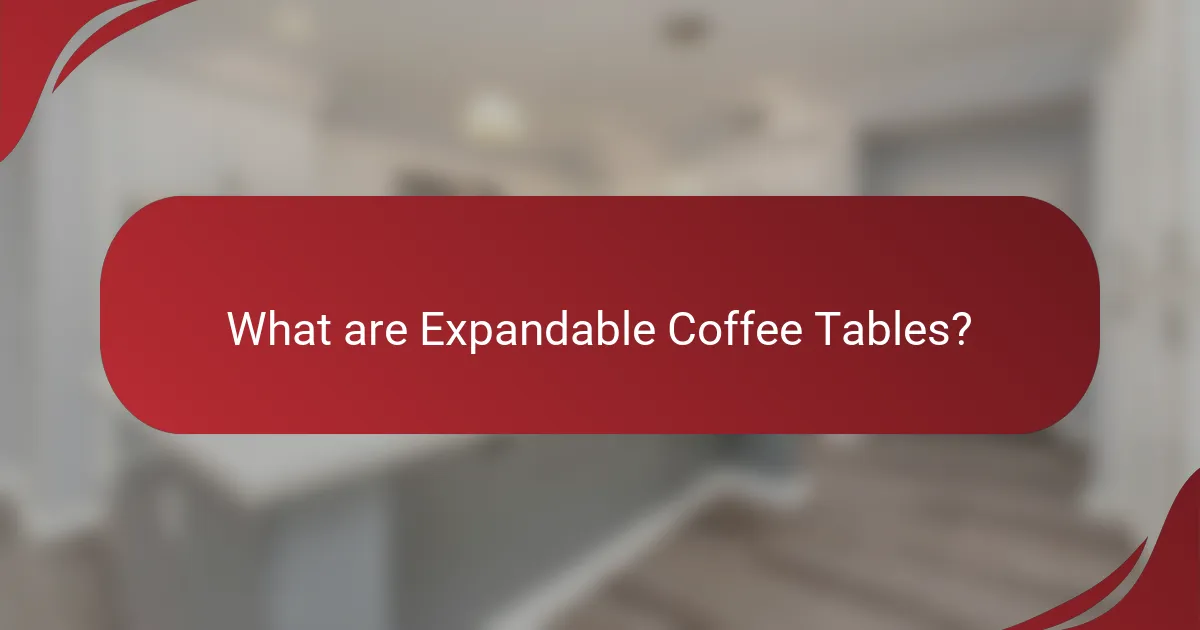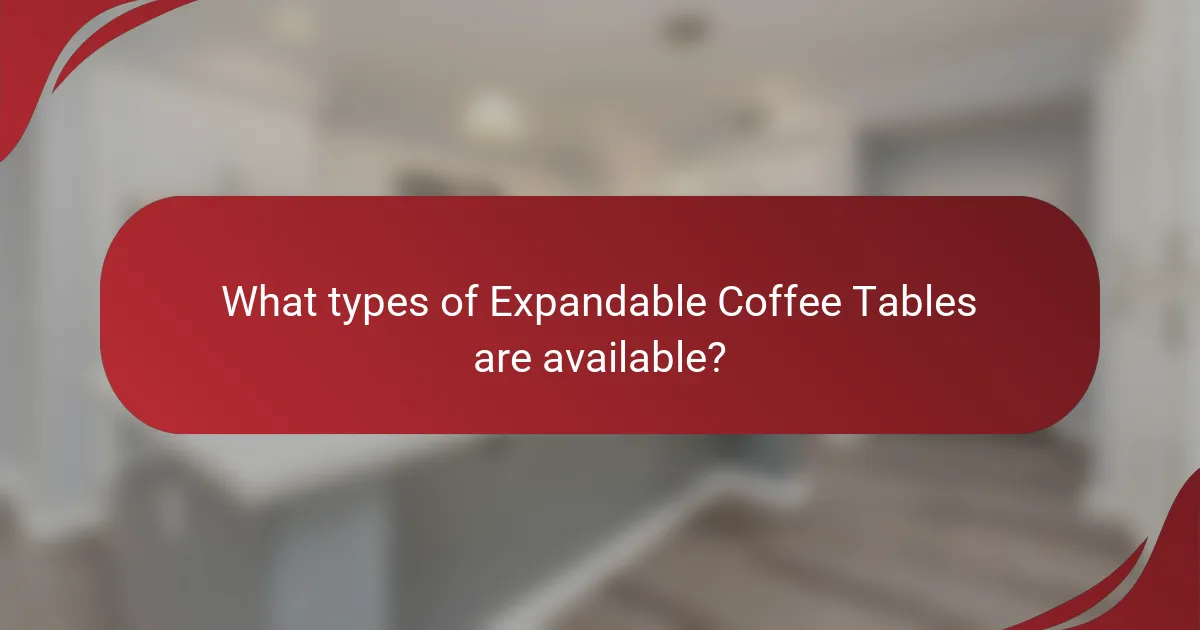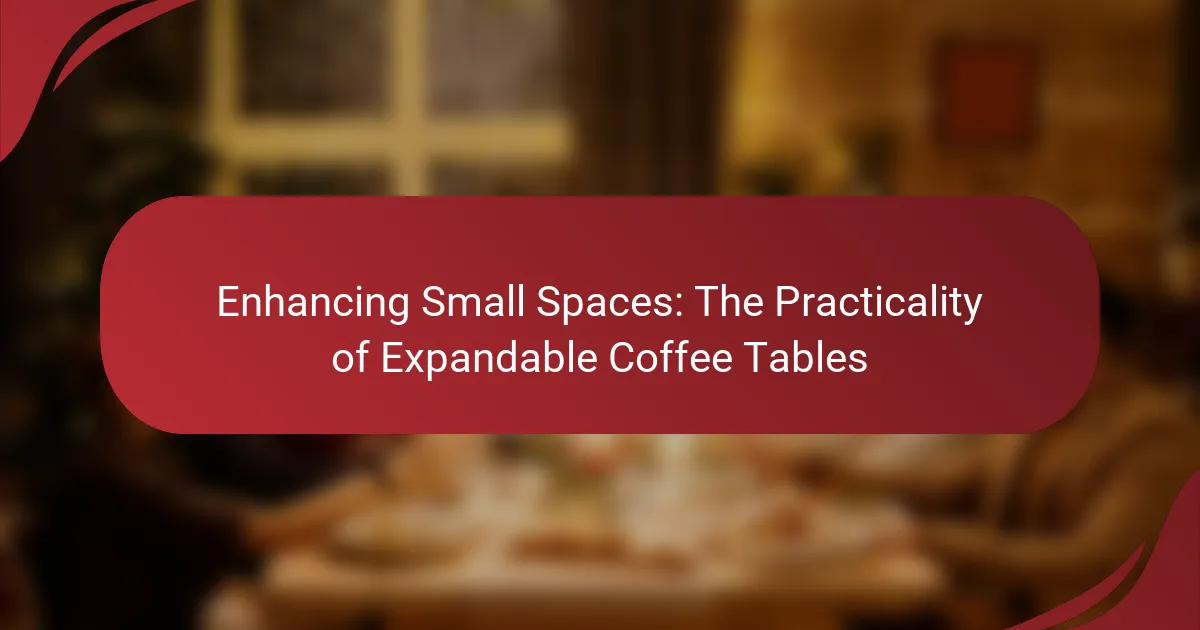Expandable coffee tables are multifunctional furniture pieces designed to adjust their size, making them ideal for small living spaces. They feature mechanisms such as lift-tops, drop-leaves, and extendable sections that allow for easy expansion or contraction. These tables not only provide additional surface area for dining or working but also often include storage options to enhance practicality. Their diverse designs cater to various aesthetics, fitting seamlessly into modern homes. This article explores how to effectively incorporate expandable coffee tables into your home, maximizing both space and functionality while complementing existing decor.

What are Expandable Coffee Tables?
Expandable coffee tables are versatile furniture pieces designed to adjust their size. They typically feature mechanisms that allow them to expand or contract. This functionality makes them ideal for small living spaces. When not in use, they can remain compact, saving space. When entertaining or needing additional surface area, they can be easily expanded. Many models also offer storage options, enhancing their practicality. These tables combine style with functionality, making them popular in modern homes. Their design caters to various aesthetics, from contemporary to traditional.
How do Expandable Coffee Tables function?
Expandable coffee tables function by utilizing a mechanism that allows them to increase in size. Typically, these tables have sections that can be pulled apart or lifted to reveal additional surface area. The most common mechanisms include sliding tops or extendable leaves. Users can easily adjust the table size according to their needs. This feature is particularly useful in small living spaces where versatility is essential. For instance, a compact table can serve as a regular coffee table and expand for dining or entertaining. The design often incorporates sturdy hinges or tracks to ensure stability when extended.
What mechanisms allow for expansion in these tables?
Expandable coffee tables utilize mechanisms such as lift-top designs and sliding components. Lift-top tables allow the tabletop to rise and create additional space for storage or dining. Sliding components enable the table to extend in length, accommodating more users. These mechanisms provide versatility in small spaces. The functionality of these designs is supported by their ability to transform a single piece of furniture into multiple uses. This adaptability makes them ideal for enhancing small living areas.
How do different designs impact functionality?
Different designs of expandable coffee tables significantly impact their functionality. A design with a lift-top feature allows for easy access to storage underneath. This enhances usability, especially in small spaces. Another design may incorporate extendable sections, providing more surface area when needed. This flexibility caters to various activities, from dining to working. Furthermore, materials used in the design affect durability and maintenance. For instance, a wooden table may offer a classic look but require more upkeep than a glass or metal option. Research shows that multifunctional furniture can improve space efficiency by up to 30%. Thus, the design directly influences how well the table serves its intended purpose.
What are the advantages of using Expandable Coffee Tables in small spaces?
Expandable coffee tables maximize functionality in small spaces. They serve as both a coffee table and dining surface. This versatility allows for efficient use of limited square footage. Expandable coffee tables can be adjusted to accommodate guests. They can be compact when not in use and expanded when needed. This flexibility enhances the livability of small areas. Additionally, they often come in stylish designs that complement modern decor. Their ability to transform from small to large makes them ideal for multifunctional rooms.
How do they optimize space in compact living areas?
They optimize space in compact living areas by utilizing multifunctional furniture. Expandable coffee tables serve as both a coffee table and a dining surface. This versatility allows for efficient use of limited square footage. Additionally, furniture that can be easily stored or collapsed enhances space flexibility. Vertical storage solutions, such as wall-mounted shelves, maximize available wall space. Implementing built-in storage, like ottomans with hidden compartments, further reduces clutter. The strategic arrangement of furniture creates open pathways, making areas feel larger. These methods collectively improve the functionality of small living spaces.
What are the aesthetic benefits of incorporating these tables?
Incorporating expandable coffee tables enhances the aesthetic appeal of small spaces. These tables offer versatility in design, allowing for various styles that complement existing decor. Their ability to transform from compact to spacious creates a dynamic visual interest. Additionally, they can serve as focal points in a room, drawing attention and enhancing overall ambiance. The use of quality materials in these tables also contributes to a sophisticated look, elevating the interior design. Moreover, their functionality combined with style promotes an organized and inviting atmosphere.

What types of Expandable Coffee Tables are available?
Expandable coffee tables are available in various types. Common types include lift-top tables, drop-leaf tables, and extendable tables. Lift-top tables have a top that rises to create a higher surface for dining or working. Drop-leaf tables feature hinged leaves that can be folded down to save space. Extendable tables come with leaves or sections that can be added or removed to adjust the size. These designs cater to different needs, making them versatile for small spaces.
What are the different styles of Expandable Coffee Tables?
Expandable coffee tables come in various styles, each catering to different aesthetics and functionalities. Common styles include modern, traditional, rustic, and industrial. Modern expandable coffee tables often feature sleek lines and minimalistic designs. Traditional styles are characterized by ornate details and classic wood finishes. Rustic tables typically incorporate reclaimed wood and a natural finish. Industrial styles often use metal and wood combinations, emphasizing raw materials. Each style serves to enhance the usability of small spaces while adding to the overall decor.
How do modern designs differ from traditional ones?
Modern designs emphasize minimalism and functionality, while traditional designs focus on ornate details and craftsmanship. Modern designs often utilize sleek lines and open spaces to create a sense of airiness. They prioritize practicality and adaptability, which is crucial for small spaces. Traditional designs typically feature intricate patterns and heavy materials that can make spaces feel more cluttered.
Modern designs frequently incorporate innovative materials like glass and metal. In contrast, traditional designs often rely on wood and textiles. The color palettes in modern designs are usually neutral and monochromatic. Traditional designs tend to use rich, bold colors and patterns.
The shift towards sustainability is also notable in modern design, with an emphasis on eco-friendly materials. Traditional designs may not prioritize sustainability to the same extent. Overall, modern designs cater to contemporary lifestyles, promoting efficiency and simplicity.
What materials are commonly used in these tables?
Expandable coffee tables are commonly made from wood, metal, and glass. Wood provides durability and a classic aesthetic. Metal offers a modern look and strength. Glass adds elegance and can create a sense of spaciousness. These materials are often chosen for their balance of style and functionality. Many tables feature a combination of these elements to enhance their appeal and practicality.
What features should you look for in an Expandable Coffee Table?
Look for versatility, durability, and design in an expandable coffee table. Versatility allows the table to adapt to different uses, such as dining or workspace. Durability ensures the table withstands daily wear and tear. Design should complement your existing decor while being functional. Consider the ease of expansion; mechanisms should be user-friendly. Stability is crucial when expanded to prevent tipping or wobbling. Size options matter; the table should fit comfortably in your space when not expanded. Finally, storage features can enhance functionality, providing space for items when not in use.
How do size and dimensions affect usability?
Size and dimensions significantly affect usability by influencing how easily users can interact with an object. For example, a coffee table that is too large may obstruct movement in a small space. Conversely, a table that is too small might not meet functional needs, such as accommodating food or drinks. Studies show that optimal dimensions enhance user experience by promoting comfort and accessibility. Research indicates that furniture dimensions should align with user height for ergonomic benefits. In small spaces, expandable coffee tables provide versatility, allowing users to adjust size based on need. This adaptability improves usability by maximizing functionality without sacrificing space.
What additional functionalities can enhance the table’s practicality?
Additional functionalities that can enhance a table’s practicality include built-in storage solutions and adjustable height features. Built-in storage can help organize items like books or remote controls, reducing clutter. Adjustable height features allow the table to serve multiple purposes, such as dining or working. These functionalities increase versatility and usability in small spaces. Research indicates that multifunctional furniture can maximize space efficiency in urban living environments. A study by the American Institute of Architects highlights the growing trend of adaptable furniture in small homes, supporting the need for practical features in tables.

How can you effectively incorporate Expandable Coffee Tables in your home?
To effectively incorporate expandable coffee tables in your home, choose a versatile design that complements your existing decor. These tables can serve multiple purposes, such as a coffee table, dining table, or workspace. Position the table in a central location for easy access. Ensure it is expandable to accommodate guests or activities. When not in use, keep it compact to save space. Select materials that match your style, like wood or metal, for aesthetic appeal. Incorporate storage options in the design to maximize functionality. Use decorative items to enhance its visual appeal without overcrowding the surface. This approach optimizes space while providing practical solutions for small areas.
What are some tips for choosing the right Expandable Coffee Table?
When choosing the right expandable coffee table, consider your space requirements first. Measure the area where the table will be placed. Ensure the table can fit comfortably when expanded and contracted. Look for tables with durable materials for longevity. Solid wood or metal frames provide stability. Evaluate the design to match your decor style. A cohesive aesthetic enhances the overall look of the room. Check the mechanism for ease of use. A smooth, reliable mechanism ensures functionality. Read reviews for user experiences on specific models. This can provide insights into quality and performance.
How can you match the table with your existing decor?
To match the table with your existing decor, select a color that complements your current palette. Consider the materials of both the table and your decor for a cohesive look. For example, a wooden table pairs well with other wooden furniture. Choose a style that aligns with your existing furniture, such as modern or rustic. Accessories like table runners or decorative items can enhance the table’s integration. Lighting also plays a role; ensure it harmonizes with the table’s design. These approaches create a unified aesthetic in your space.
What considerations should you keep in mind for maintenance?
Regular cleaning is essential for maintaining expandable coffee tables. Use a soft cloth and mild cleaner to avoid damage. Check for loose screws or joints periodically to ensure stability. Avoid placing heavy items on the table to prevent warping. Keep the table away from direct sunlight to prevent fading. Use coasters to protect the surface from heat and moisture. If the table has a finish, reapply it as needed to maintain its appearance. Regular maintenance prolongs the table’s lifespan and keeps it functional.
What are common challenges when using Expandable Coffee Tables?
Common challenges when using expandable coffee tables include stability issues when extended. Many models may wobble or feel less sturdy when expanded. Users often find them difficult to adjust, especially if mechanisms are stiff or complex. Limited space can also hinder their functionality. In smaller areas, maneuvering around the table can be problematic. Additionally, some designs may not blend well with existing decor. This can lead to aesthetic mismatches in a room’s overall design. Regular maintenance is necessary to ensure smooth operation, which can be overlooked. These challenges highlight the need for careful consideration before purchasing.
How can you troubleshoot common issues?
To troubleshoot common issues with expandable coffee tables, first identify the specific problem. Check for stability; if the table wobbles, ensure all legs are securely attached. If the expansion mechanism is stuck, inspect for debris or obstructions. Lubricate moving parts if necessary. For scratches or damage, use appropriate wood polish or repair kits. If the table does not expand or contract smoothly, examine the hinges and tracks for misalignment. Ensure the surface is clean and free from moisture, which can affect functionality. Regular maintenance can prevent many common issues.
What solutions exist for maximizing space with these tables?
Expandable coffee tables provide solutions for maximizing space in small areas. They can be adjusted in size to suit various needs. For instance, they can be compact for everyday use and expanded for gatherings. This flexibility allows for efficient use of limited space. Additionally, some models come with built-in storage options. These features help to declutter the area. Using multifunctional furniture, such as a coffee table that converts into a dining table, also maximizes space. Research indicates that multifunctional furniture can enhance spatial efficiency by up to 30%. Thus, expandable coffee tables are effective for optimizing small living spaces.
What practical advice can enhance the use of Expandable Coffee Tables?
To enhance the use of expandable coffee tables, prioritize their multifunctionality. Select tables that can easily transition from a coffee table to a dining surface. This adaptability maximizes space efficiency in small areas. Consider tables with built-in storage options. Storage compartments help keep the living area organized and clutter-free. Use the table for various activities, such as work or games, to increase its utility. Regularly assess the layout of your space. A well-placed table can improve flow and accessibility. Additionally, choose designs that complement your decor. Aesthetic appeal can enhance the overall ambiance of the room.
Expandable coffee tables are multifunctional furniture pieces designed to optimize space in small living areas by adjusting their size. This article explores the various mechanisms that facilitate their expansion, the advantages they offer in compact living spaces, and the aesthetic benefits they bring to home decor. It discusses different types and styles of expandable coffee tables, materials used, and essential features to consider when choosing one. Additionally, practical advice on incorporating these tables into existing decor and troubleshooting common issues is provided, highlighting their role in enhancing usability and efficiency in small spaces.
